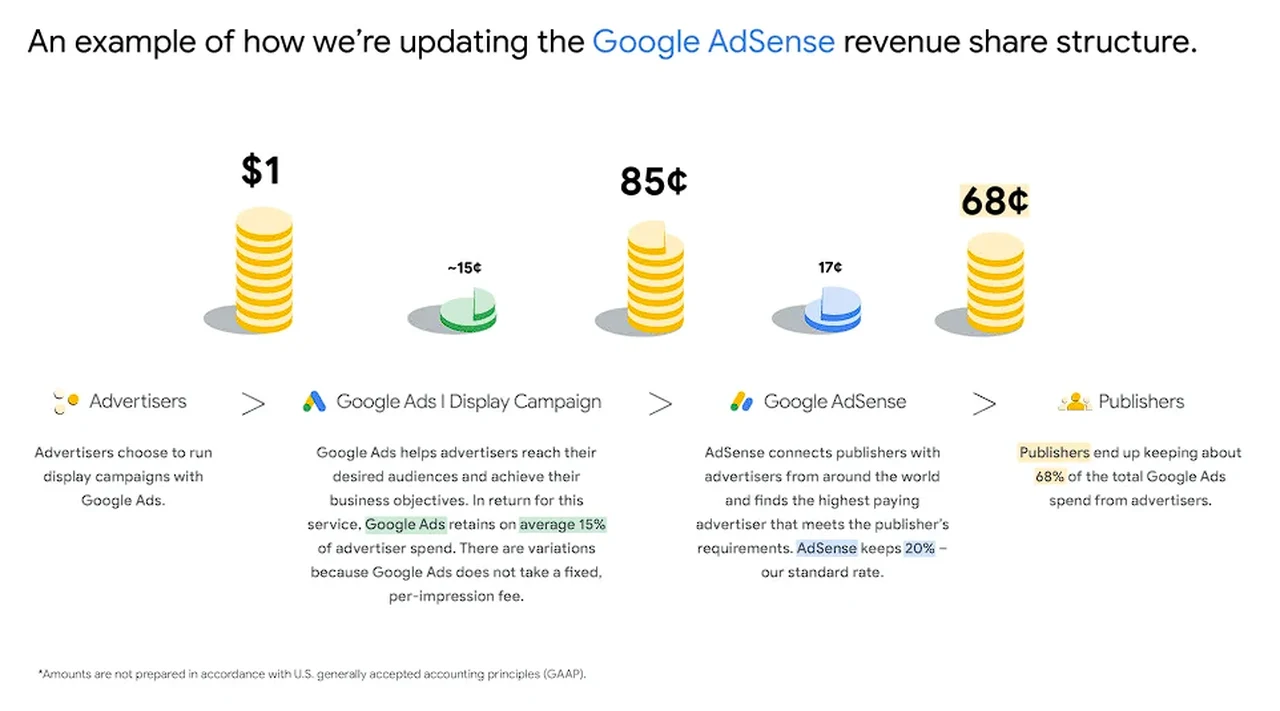
Google AdSense has announced two significant changes to its operations that will directly impact publishers. These modifications include an update to AdSense’s revenue-share structure and a shift in the payment method from a per-click to a per-impression basis. Google AdSense has been instrumental in shaping the digital advertising industry and provides a platform for publishers to monetize their content and advertisers to reach their target audience.
For displaying ads with AdSense for content, publishers will receive 80% of the revenue after the advertiser platform takes its fee, whether that be Google’s buy-side or third-party platforms. When Google Ads purchases display ads on AdSense, Google Ads will retain on average 15% of advertiser spend. However, publishers will continue to keep about 68% of the revenue. When advertisers use a third-party platform to purchase display ads on AdSense, publishers will keep 80% of the revenue after the third-party platform has taken its fee.
Since its inception two decades ago, Google AdSense has been a key player in the digital advertising landscape, connecting publishers with advertisers and facilitating the monetization of online content. Over the years, the platform has continually evolved to meet the changing needs of the digital advertising industry, and the most recent modifications continue this trend.
Google AdSense payments change
The first of the two changes involves an update to AdSense’s revenue-share structure. Previously, AdSense processed fees within a single transaction, but under the new structure, the revenue share will be split into separate rates for the buy-side and sell-side. This means that for displaying ads with AdSense for content, publishers will now receive 80% of the revenue after the advertiser platform takes its fee. This applies whether the buy-side is Google or a third-party platform.

When Google Ads purchases display ads on AdSense, it will retain on average 15% of advertiser spend, leaving publishers with about 68% of the revenue. When a third-party platform purchases display ads on AdSense, publishers will keep 80% of the revenue after the platform has taken its fee. It’s important to note that Google does not control or have visibility into the fees that these third-party platforms charge.
Adsense impression payment
The second significant change is a shift in the payment method. AdSense will transition from primarily paying publishers per click to paying per impression. This change aligns AdSense with the display industry standard and is expected to have a significant impact on how publishers earn from their content.
Despite these changes, the type or quantity of ads publishers can display on their websites will not be influenced. Publishers must continue to adhere to Google’s AdSense policies and the Better Ads Standards, ensuring that the quality of the ads remains high and the user experience is not compromised.
Coming into effect next year
These updates are slated to go into effect early next year and do not require any action from publishers. Google’s aim with these changes is to continue contributing to the open web and the access to content that advertising supports, while simultaneously simplifying the process and providing greater transparency.
The potential impact of these changes on publishers’ earnings is a topic of great interest. The shift to per-impression payments is expected to provide a more consistent and predictable revenue stream for publishers, while the new revenue share structure could potentially increase publishers’ earnings, especially when ads are purchased by third-party platforms.
Google AdSense’s modifications to its revenue-share structure and payment method represent a significant shift in the platform’s operations. As the digital advertising industry continues to evolve, these changes reflect Google’s ongoing commitment to transparency, simplicity, and supporting the open web. Publishers, meanwhile, can look forward to potential increases in their earnings and a more predictable revenue stream. As these updates are implemented, the digital advertising landscape is set to undergo yet another transformation.
Potential impact of each change
- Update to Revenue-Share Structure:
- Publishers might see a more transparent breakdown of revenue, with 80% of the ad revenue after fees when a third-party platform is involved. However, when Google Ads is the buyer, publishers will receive about 68% of the ad revenue. The stated aim is to provide publishers with a greater share of the revenue, which could be beneficial if the actual share after all deductions is higher than before.
- Google AdSense may benefit from this change by positioning itself as a more transparent and fair platform, potentially attracting more publishers and advertisers. By offering a higher revenue share when third-party platforms are involved, Google may encourage a more competitive advertising ecosystem on its platform.
- Shift from Pay-per-Click to Pay-per-Impression:
- Publishers with content that garners a high number of impressions but fewer clicks may benefit from a more consistent and predictable revenue stream. This can be particularly advantageous for publishers who specialize in content that is widely viewed but not necessarily clicked on, such as news or informational sites.
- Advertisers might have to adjust their strategies and budgets since they will now pay for impressions instead of clicks. This could potentially lead to higher costs for advertisers if the conversion rates from impressions to clicks are not optimized.
- Google AdSense aligns itself with industry standards, which may streamline its operations and make its platform more attractive to advertisers accustomed to paying for impressions.
The net effect of these changes on publishers’ earnings will depend on various factors, such as the balance between clicks and impressions on their sites, the proportion of ads bought by Google versus third-party platforms, and the efficiency of Google’s ad placement. Overall, the promise is a more consistent and potentially larger income for publishers and a more transparent operation from Google AdSense.
Google AdSense’s decision to update its revenue-share structure and transition to per-impression payments is a significant shift in its operations. The new revenue-share structure will separate rates for the buy-side and sell-side, providing more transparency and consistency across various monetization technologies. Meanwhile, the move to per-impression payments aligns AdSense with the broader industry trend, offering a more uniform payment method for publishers. Despite these changes, publishers’ earnings are not expected to change, and they will still be required to adhere to Google’s AdSense policies and the Better Ads Standards.
Source : Google
Filed Under: Technology News, Top News
Latest timeswonderful Deals
Disclosure: Some of our articles include affiliate links. If you buy something through one of these links, timeswonderful may earn an affiliate commission. Learn about our Disclosure Policy.

